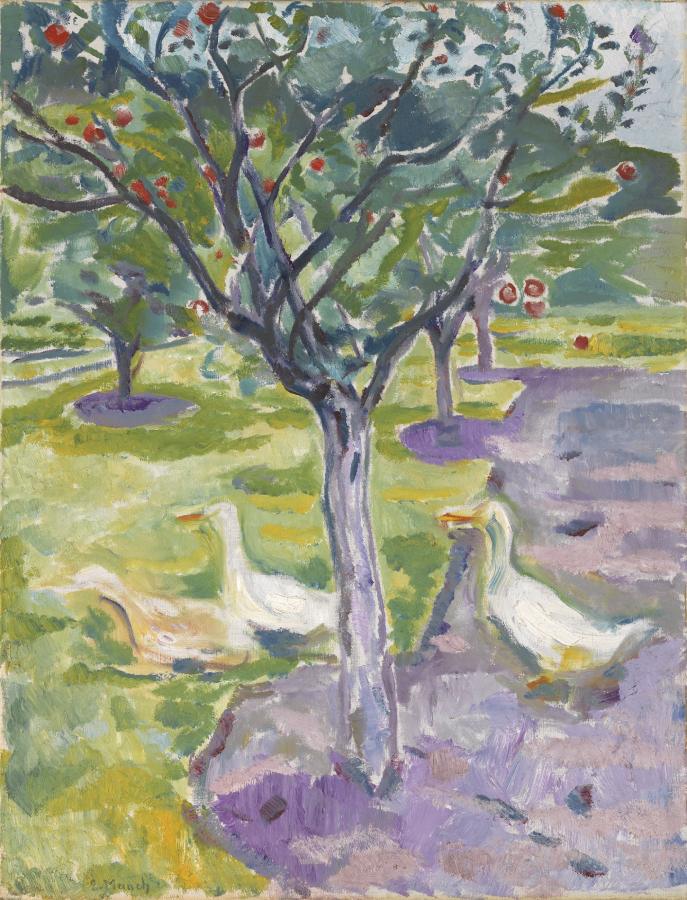Munch, Edvard (1863-1944)
Geese in an Orchard
c.1911
Oil on canvas, 90 x 68 cm
Museo Thyssen-Bornemisza, Madrid
©Munch Museum / Munch-Ellingsen Group / VEGAP, Madrid
Carmen Thyssen Collection
In 1911, after a short stay in Germany and after opening an important exhibition of his works in the Diorama Halls in Oslo, Munch spent the autumn and winter in Kragerø, where he painted various landscapes and made studies of animals. Geese in an Orchard was probably executed either in that period in Kragerø, or in his recently acquired property in Hvitsten, where he had been living that year before the previously mentioned trip to Germany. In those villages in the fjord of Oslo, Munch rebuilt his artistic life after being treated for his nervous breakdowns and his alcohol abuse in Dr Daniel Jacobson’s neurological clinic in Copenhagen. He had been hospitalised there from October 1908 until the spring of 1909. In his paintings, the period following this treatment is characterised stylistically by the use of brighter colours and greater contrast, as well as a wider brushstroke. The painting Geese in an Orchard is painted with dainty touches of colour and ample marks, delicately highlighting the contrasts between black and white, and between green and purple, with the matt finishing characteristic of the Norwegian painter, always reluctant to using varnish. In the foreground, the colour patches show better the marks of the brushstrokes and the mixture of the different shades, while the allusion to texture is almost non existent in the background. The bright and serene colours complement a clearly structured composition, with a simple organisation of the different parts. The dramatic imagery and tense emotion of Munch‘s previous paintings give way here to a happier, more spontaneous visual image.
It would seem that Geese in an Orchard lacks the allegorical connotations habitual in other works by Munch; those in which he shows more the existential seriousness of his vision of human beings and of nature, like in the subjects of vampirism, love, loneliness, summer night, death, women by the seashore and others. He shows three geese walking through an orchard, the view of which is dominated by a large apple tree taking up the centre of the composition. Although the scene does not really develop a subject, Munch does gather here motifs used in paintings with a much clearer symbolic connotation. The placing of the apple tree in the central axis of the image coincides, for example, with the pastel work of 1909–10 Adam and Eve (Oslo, Munch-Museet) or with another symbolic representation of love, the oil painting of 1894 Eyes in eyes (also in Oslo, Munch-Museet), where we find the tree flanked by a woman and a man. The idea of life is incarnated in the image of the tree in many works by Munch, such as in the etching of 1902, Life and Death, the oil painting of 1910, Life (Oslo, Town Hall), representing the tree surrounded by six people of different age, or a previous work of 1898, Fecundity (private collection), in which a couple of peasants stands by a cherry tree. The combination of the tree motif with that of the geese is not new either. In the oil Children and Geese (Oslo, Munch-Museet), the position of the tree, in contrast with the other examples mentioned, is not rigorously axial, although it is in the central part of the composition. This painting, dated between 1905 and 1908, represents two groups of children, one of which, mainly composed of girls, closely surrounds a tree, while some geese appear in the foreground. There is therefore no reason to remove from the painting Geese in an Orchard a semantic reading which goes beyond that of the representation of a farm scene.
Indeed, the emphatic position of the apple tree, the closeness of the innocent animal life and the colourful image of fertility represented in this picture transform it, rather than in the reflection of a chosen visual reality, into an intentional iconographic representation of life. Munch said that “a work of art is like a crystal; and in the same way that a crystal has its own interior life, its own will, a work of art has to have the same qualities”. What makes this picture singular, among the examples mentioned, is the total removal of rhetorical colourings and dramatic expressions, bringing together the representation of a simple scene, with no literary connotations, almost insignificant, and the realisation of an artistic intention analogous to the life represented, to which it gives a subtle metaphorical meaning.
Javier Arnaldo (T-B)
